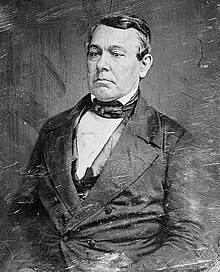Thomas Corwin | |
|---|---|
 | |
| 20th United States Secretary of the Treasury | |
| In office July 23, 1850 – March 6, 1853 | |
| President | Millard Fillmore Franklin Pierce |
| Preceded by | William M. Meredith |
| Succeeded by | James Guthrie |
| United States Minister to Mexico | |
| In office May 21, 1861 – April 27, 1864 | |
| President | Abraham Lincoln |
| Preceded by | John B. Weller |
| Succeeded by | Robert Shufelt |
| United States Senator from Ohio | |
| In office March 4, 1845 – July 20, 1850 | |
| Preceded by | Benjamin Tappan |
| Succeeded by | Thomas Ewing |
| 15th Governor of Ohio | |
| In office December 16, 1840 – December 14, 1842 | |
| Preceded by | Wilson Shannon |
| Succeeded by | Wilson Shannon |
| Member of the U.S. House of Representatives from Ohio | |
| In office March 4, 1831 – May 30, 1840 | |
| Preceded by | James Shields |
| Succeeded by | Jeremiah Morrow |
| Constituency | 2nd district (1831–1833) 4th district (1833–1840) |
| In office March 4, 1859 – March 12, 1861 | |
| Preceded by | Aaron Harlan |
| Succeeded by | Richard A. Harrison |
| Constituency | 7th district |
| Member of the Ohio House of Representatives from the Warren County district | |
| In office 1829–1830 | |
| Preceded by | Benjamin Baldwin James McEwen |
| Succeeded by | Jacoby Halleck Joseph Whitehill |
| In office 1821–1823 | |
| Preceded by | John Bigger William Schenck |
| Succeeded by | John Houston David Sutton |
| Personal details | |
| Born | July 29, 1794 Bourbon County, Kentucky, U.S. |
| Died | December 18, 1865 (aged 71) Washington, D.C., U.S. |
| Political party | Whig (Before 1858) Republican (1858–1865) |
| Spouse | Sarah Ross |
| Signature | |
Thomas Corwin (July 29, 1794 – December 18, 1865), also known as Tom Corwin, The Wagon Boy, and Black Tom was a politician from the state of Ohio. He represented Ohio in both houses of Congress and served as the 15th governor of Ohio and the 20th Secretary of the Treasury. After affiliating with the Whig Party, he joined the Republican Party in the 1850s. Corwin is best known for his sponsorship of the proposed Corwin Amendment, which was presented in an unsuccessful attempt to avoid the oncoming American Civil War.
Corwin was born in Bourbon County, Kentucky, but he grew up in Lebanon, Ohio. After serving as a wagon boy in the War of 1812, he established a legal practice in Lebanon. He became a prosecuting attorney and won election to the Ohio House of Representatives. He served in the United States House of Representatives from 1830 to 1840, resigning from Congress to take office as Ohio's governor. He was defeated for re-election in 1842 but was elected by the state legislature to the United States Senate in 1844. As a Senator, he became a prominent opponent of the Mexican–American War. He resigned from the Senate to become Secretary of the Treasury under President Millard Fillmore.
Corwin returned to the United States House of Representatives in 1859. He led the House of Representatives' effort to end the secessionist crisis that arose following the 1860 elections. Corwin sponsored a constitutional amendment that would have forbidden the federal government from outlawing slavery, even through further constitutional amendments. Though several states ratified the amendment, it did not prevent the outbreak of the civil war. Corwin resigned from Congress in March 1861 to become the United States Ambassador to Mexico. He held that position until 1864 and died the following year.